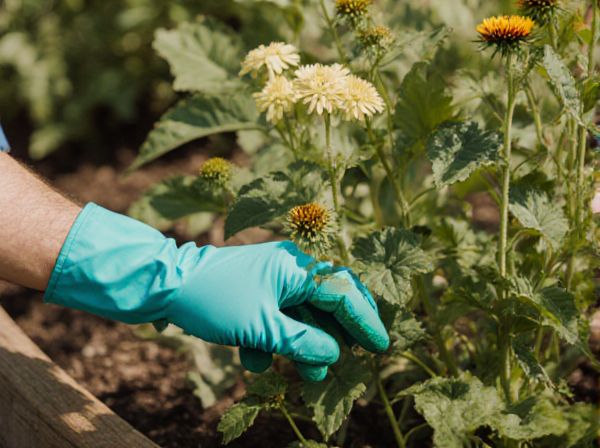
Pollenizer vs Pollinator Illustration
A pollenizer is a plant that provides viable pollen necessary for the fertilization of another plant, while a pollinator is an agent, such as bees, birds, or wind, that transfers pollen from one flower to another enabling fertilization. Pollinators facilitate the reproductive process by moving pollen, but they do not produce pollen themselves. Understanding the distinction between pollenizer and pollinator is crucial for effective orchard management and maximizing crop yields.
Table of Comparison
| Feature | Pollenizer | Pollinator |
|---|---|---|
| Definition | Plant that produces compatible pollen | Agent that transfers pollen for fertilization |
| Role in pollination | Source of pollen | Carrier of pollen |
| Examples | Apple tree variety providing pollen | Bees, butterflies, wind |
| Function | Ensures genetic diversity via pollen | Facilitates pollen movement between flowers |
| Type | Plant | Insect, animal, or abiotic factor |
Understanding Pollinizers and Pollinators
Pollinizers are specific plants that produce compatible pollen necessary for fertilizing and fruit development, while pollinators are the agents, such as bees, butterflies, or wind, that transfer this pollen between flowers. Understanding the role of pollinizers ensures proper cross-pollination, which is essential for optimal crop yield and genetic diversity in plants. Effective pollination relies on the interaction between the right pollinizer species and efficient pollinators to maximize reproductive success in agriculture and natural ecosystems.
Key Differences Between Pollinizers and Pollinators
Pollinizers are specific plants or trees that produce compatible pollen required for fertilization in fruit-bearing plants, whereas pollinators are animals or agents such as bees, butterflies, birds, and wind that transfer pollen from the male anthers to the female stigma. The key difference lies in their roles: pollinizers serve as the source of pollen, while pollinators act as the vectors facilitating the actual pollen movement. Understanding this distinction enhances orchard management and crop yield optimization by strategically selecting pollinizers and encouraging pollinator activity.
Why Pollenizers Matter in Your Garden
Pollenizers are essential plants that provide compatible pollen to pollinators, enabling effective fertilization and fruit production in your garden. While pollinators transfer pollen, without the right pollenizer species nearby, fruit trees and plants may fail to yield or produce poor-quality fruit. Incorporating appropriate pollenizers enhances crop diversity, increases fruit yield, and supports overall garden ecosystem health.
The Essential Role of Pollinators in Plant Reproduction
Pollinators, such as bees, butterflies, and birds, play a crucial role in plant reproduction by transferring pollen from the male anthers of a flower to the female stigma, enabling fertilization and the production of seeds. Unlike pollenizers, which are plants that provide the pollen necessary for fertilization, pollinators actively facilitate this transfer across different plant species, ensuring genetic diversity and crop yield. The effectiveness of pollinators directly influences the success of fruit and seed development in both wild ecosystems and agricultural environments.
Choosing Effective Pollenizer Plants
Choosing effective pollenizer plants requires understanding their role in enhancing fruit set by providing compatible pollen to pollinator plants. Pollenizers must bloom simultaneously with the main crop and possess high pollen viability to maximize cross-pollination efficiency. Selecting species or cultivars known for strong pollen production and genetic compatibility ensures improved yields and fruit quality in orchards or gardens.
Supporting Pollinator Populations Naturally
Pollenizers are specific plants that provide viable pollen to fertilize other plants, enhancing fruit and seed production, while pollinators are animals, primarily insects like bees, that transfer pollen between flowers. Supporting pollinator populations naturally involves planting diverse native flowering plants that bloom throughout the growing season, offering continuous nectar and pollen sources. Creating habitats with varied vegetation and minimizing pesticide use are essential strategies to sustain healthy pollinator ecosystems.
Common Examples of Pollenizers and Pollinators
Pollenizers such as specific apple tree varieties or avocado cultivars provide the necessary pollen for fertilization, without directly assisting in pollen transfer. Common pollinators include bees, butterflies, and birds, which actively carry pollen from one flower to another, facilitating cross-pollination. While pollenizers supply compatible pollen, pollinators play a crucial role by moving pollen to enable fruit and seed production.
Maximizing Fruit Yield with Proper Pairings
Choosing the right pollenizer over a general pollinator can significantly enhance fruit yield by ensuring consistent and compatible pollen transfer among plants. Proper pairings between specific pollenizer varieties promote effective cross-pollination, which directly influences fruit set, size, and quality. Incorporating scientifically matched pollenizers into orchard design optimizes pollination efficiency and maximizes overall crop productivity.
Troubleshooting Poor Pollination in Gardens
Pollenizers provide compatible pollen necessary for fruit set, while pollinators actively transfer pollen between flowers, essential for successful fertilization. Troubleshooting poor pollination in gardens involves ensuring the presence of both adequate pollenizer plants and active pollinators like bees or butterflies. Gardeners should assess flower compatibility, pollinator activity, and environmental conditions to improve fruit yield effectively.
Creating a Pollinator-Friendly Gardening Environment
Pollenizers are specific plants that provide compatible pollen necessary for fertilizing fruit plants, while pollinators are animals, often bees or butterflies, that transfer this pollen between flowers. Creating a pollinator-friendly gardening environment involves planting a diverse array of native flowering plants that bloom at different times, offering continuous nectar and pollen sources. Incorporating both effective pollenizer species and attracting pollinators enhances cross-pollination, leading to higher fruit yield and garden biodiversity.
Pollenizer vs Pollinator Infographic

 gardendif.com
gardendif.com